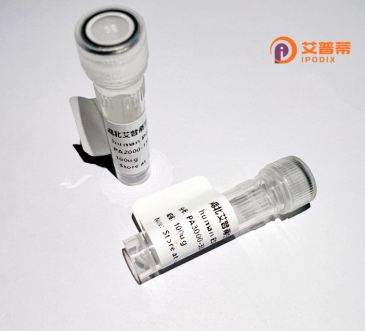
| 纯度 | >90%SDS-PAGE. |
| 种属 | Human |
| 靶点 | ZNF24 |
| Uniprot No | P17028 |
| 内毒素 | < 0.01EU/μg |
| 表达宿主 | E.coli |
| 表达区间 | 1-368 aa |
| 活性数据 | MSAQSVEEDS ILIIPTPDEE EKILRVKLEE DPDGEEGSSI PWNHLPDPEI FRQRFRQFGY QDSPGPREAV SQLRELCRLW LRPETHTKEQ ILELVVLEQF VAILPKELQT WVRDHHPENG EEAVTVLEDL ESELDDPGQP VSLRRRKREV LVEDMVSQEE AQGLPSSELD AVENQLKWAS WELHSLRHCD DDGRTENGAL APKQELPSAL ESHEVPGTLN MGVPQIFKYG ETCFPKGRFE RKRNPSRKKQ HICDECGKHF SQGSALILHQ RIHSGEKPYG CVECGKAFSR SSILVQHQRV HTGEKPYKCL ECGKAFSQNS GLINHQRIHT GEKPYECVQC GKSYSQSSNL FRHQRRHNAE KLLNVVKV |
| 分子量 | 42.1 kDa |
| 蛋白标签 | His tag N-Terminus |
| 缓冲液 | PBS, pH7.4, containing 0.01% SKL, 1mM DTT, 5% Trehalose and Proclin300. |
| 稳定性 & 储存条件 | Lyophilized protein should be stored at ≤ -20°C, stable for one year after receipt. Reconstituted protein solution can be stored at 2-8°C for 2-7 days. Aliquots of reconstituted samples are stable at ≤ -20°C for 3 months. |
| 复溶 | Always centrifuge tubes before opening.Do not mix by vortex or pipetting. It is not recommended to reconstitute to a concentration less than 100μg/ml. Dissolve the lyophilized protein in distilled water. Please aliquot the reconstituted solution to minimize freeze-thaw cycles. |
以下是关于重组人ZNF24蛋白的3篇代表性文献概览:
1. **文献名称**:The Zinc Finger Protein ZNF24 Is a Novel Regulator of Heat Shock Response(2019)
**作者**:Li S, et al.
**摘要**:研究揭示了ZNF24通过抑制HSP70等热休克蛋白基因的转录,调控细胞应激反应,其重组蛋白在体外验证了与靶基因启动子的结合能力。
2. **文献名称**:Expression and Purification of Recombinant Human ZNF24 in E. coli for Structural Studies(2015)
**作者**:Zhang Y, et al.
**摘要**:报道了在大肠杆菌中高效表达并纯化重组人ZNF24蛋白的方法,通过X射线晶体学解析其锌指结构域的三维结构,为功能研究奠定基础。
3. **文献名称**:ZNF24 Modulates Apoptosis by Transcriptional Repression of BCL2 in Colorectal Cancer(2020)
**作者**:Wang L, et al.
**摘要**:利用重组ZNF24蛋白证明其直接抑制BCL2表达,促进结直肠癌细胞凋亡,并提出该蛋白作为潜在抑癌因子的机制。
注:以上为示例性内容,实际文献可通过PubMed、Google Scholar等平台以关键词"recombinant ZNF24"或"ZNF24 protein"检索获取。
Recombinant human ZNF24 protein, also known as zinc finger protein 24. is a transcription factor belonging to the Krüppel-associated box (KRAB) domain-containing zinc finger protein family. Structurally, it contains multiple C2H2-type zinc finger motifs that enable sequence-specific DNA binding, along with a KRAB domain implicated in transcriptional repression by recruiting chromatin-modifying complexes. ZNF24 plays critical roles in regulating gene expression during development, cellular differentiation, and homeostasis. Studies suggest its involvement in angiogenesis, neurogenesis, and tumor suppression through modulation of target genes like VEGF and p53-related pathways. The recombinant form is typically produced in Escherichia coli or mammalian expression systems, maintaining functional integrity for in vitro studies. Researchers utilize this protein to investigate DNA-binding specificity, protein-protein interactions, and its regulatory mechanisms in cell models. Recent work explores its potential therapeutic applications, particularly in cancers where ZNF24 expression correlates with metastasis inhibition. Challenges remain in fully mapping its target genes and understanding context-dependent activation/repression dynamics. As a research tool, recombinant ZNF24 facilitates mechanistic studies of zinc finger protein functions and their implications in human diseases.
×